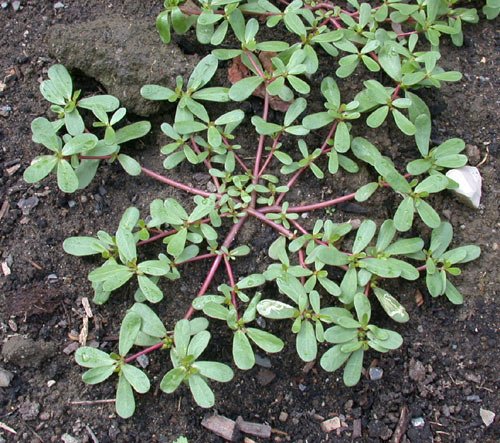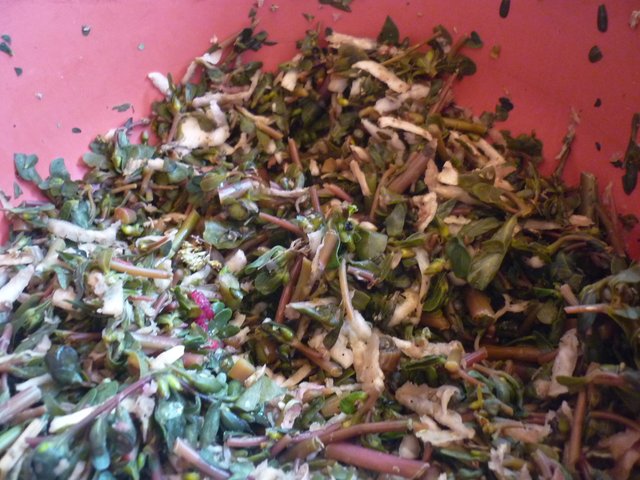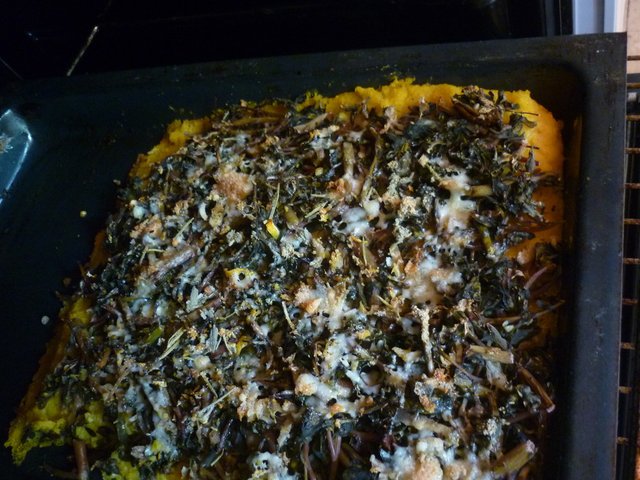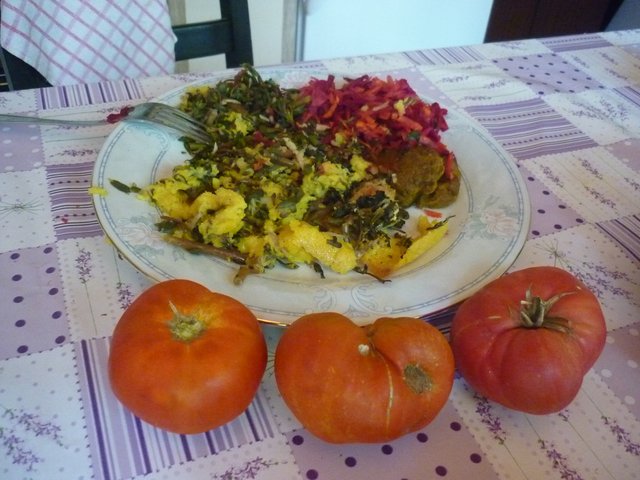About purslane & lunch inspiration
My first post will be devoted to a wild plant we call tušt: Portulaca oleracea, purslane.

That's because it played the main role in my today's lunch. I'm still delighted and grateful!
The leaves are thick and bounteous, the stems also. We pick and prepare both stems and leaves. The taste is... well, no specific, but when cooked for a minute in boiling water, it's like a very tasty silverbeet...

So that's what I did, and then cut it in tiny bits, added some grated celery and herbs I picked on the seaside (the beloved Adriatic): wild origano, rosemary and sage. Plus a bit of salt.
With some parmesano, it became the top for the polenta-pizza... (Gluten-intolerants, focus!)

So purslane grows as a weed asap on any ground that has been cleaned & prepared for growing something. Although mostly forgotten (my mum saw it on the streetmarket in Šibenik, on the coast, last year tho), it's very healthy plant - most often its richness in omega 3 is pointed out.
It's known in some traditional cuisines, mostly of mediterranean countries. Wikipedia is mentioning Greek, Egyptian, Portuguese and Albanian dishes with purslane in it. And, surprisingly, also Native Australian! They were making seedcakes.
I also read an article (credits to Stribor Marković) about something nutritionists called "the Cretan diet": the research showed that people of the Mediterranean countries had less heart and blood system diseases, and of those the Cretans had even less problems of that kind... They looked into their diets to find the difference, and it turns out that one of the main ones is that Cretans use more wild green plants in their diet then anyone else. Here's how the article is concluded:
"With a little effort, many people can follow the basic features of a Cretan diet—plant some purslane, be picky about the hamburger and eggs you buy, and, yes, consume more olive oil, fish, and wine." (http://www.todaysdietitian.com/newarchives/tdaug2007pg34.shtml)
And my conclusion for today is... purslane + celery + rosemary, origano, sage.... just divine <3
Hope I inspired you for trying out... Gardeners, take a closer look to your weed... Could easily be there's some secret treasure in it ;))
Мой первый пост посвящен дикорастущем растении, которое мы в Хорватии называем tušt, а иногда, как и русские, портулак (Portulaca oleracea). Это потому, что он сыграл важнейшую роль в моем сегодняшнем обеде. Я все же восхищена и благодарна!
Листья толстые и богатые, стебли также. Мы собираем и готовим и стебли и листья. Вкус такой... ну, не очень специфичный, но, когда сварен на минуточку в кипящей воде, это будет как очень вкусный мангольд.
Итак, это было именно то, что я сделала, потом нарезала на мелкие кусочки, прибавила тертого сельдерея и трав, которые я собрала на море (любимой Адриатике): душицу, розмарин, шалфей. Плюс щепотка соли.
С добавкой пармезана, это стало начинкой полента-пиццы. (Глютенщики, фокус!)
Итак, портулак растет как сорняк очень быстро на любой почве, которую очистили и приготовили к выращиванию чего-нибудь. Хотя про него, в общем, забыли (хотя моя мама видела его прошлым летом на рынке в Шибенике, в Далмации), это очень полезное растение - чаще всего делается ударение на его богатсво омега 3 жирными кислотами.
Его можно найти в некоторых традиционных кухнях, больше всего медитеранских. Википедия упоминает греческие, египетские, португальские и албанские блюда с портулаком. И, что удивляет, даже абпрогенскую! Они делали пироги из семен портулака.
Я также когда-то читала статью (спасибо Stribor Marković кое о чем, что нутриционисты называют "критское питание (критская диета)": исследования показали, что люди медитеранских стран меньше страдают сердечно-сосудистыми заболеваниями, а среди них жители Крита даже меньше других... Потом обисследовали их питание, чтобы найти, в чем разница, и показалось, что одна из главных разниц состоит в том, что на Крите пользуюсь намного больше дикорастущими растениями, чем на других местах. Вот вывод статьи:
"Если немножко постараться, многие могут слеовать за основными признаками критской диеты - вырастить портулак, быть разборчивым при выборе хамбургеров и яйц, и, да, есть больше оливкового масла, рыбы, и вина."
А мой сегодняшний вывод... портулак + сельдерей + розмарин, душица, шалфей... просто прелест <3
Надеюсь, что я вас инспирировала, и что попробуете... Огородники, обратите внимание на свой сорняк... Совсем возможно, что там есть такое благо ;))

le lunch... to enjoy the colors!
<3
Congratulations @danijela00! You have completed some achievement on Steemit and have been rewarded with new badge(s) :
Click on any badge to view your own Board of Honor on SteemitBoard.
For more information about SteemitBoard, click here
If you no longer want to receive notifications, reply to this comment with the word
STOP